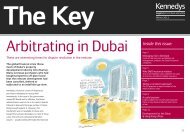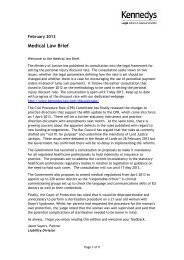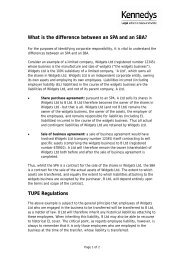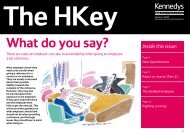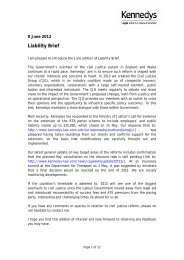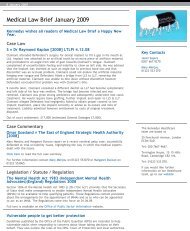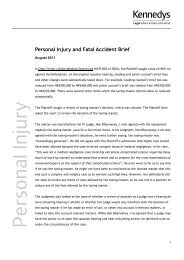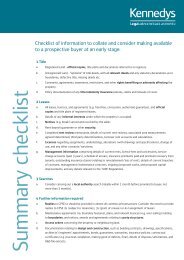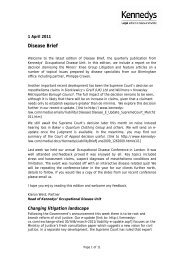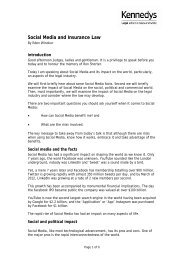Download Commodities Brief - December 2011 (PDF ... - Kennedys
Download Commodities Brief - December 2011 (PDF ... - Kennedys
Download Commodities Brief - December 2011 (PDF ... - Kennedys
You also want an ePaper? Increase the reach of your titles
YUMPU automatically turns print PDFs into web optimized ePapers that Google loves.
<strong>Commodities</strong> <strong>Brief</strong><br />
<strong>December</strong> <strong>2011</strong><br />
Time bars and indemnities – commercial sense and certainty<br />
In this edition of <strong>Commodities</strong> <strong>Brief</strong>, we highlight two recent English legal decisions involving demurrage<br />
claims and time bars, and a Uniform Customs and Practice for Documentary Credits (UCP 600) case involving<br />
indemnities under a credit facility and the obligations of a confirming bank.<br />
Glencore Energy (UK) Ltd v Sonol Israel Ltd (<strong>2011</strong>)<br />
This was a claim by the sellers (Glencore) against the buyers (Sonol) for unpaid demurrage, which the buyers<br />
resisted, and applied to strike out, on the basis that it was time-barred.<br />
The sellers entered into two contracts to sell gasoil in late 2004, and the gasoil was procured from BP<br />
on CIF basis. The sale contracts stated that demurrage was to be “as per charter-party rate, terms<br />
and conditions”.<br />
The performing vessel, the “Team Anmaj”, arrived at the discharge port in Israel in <strong>December</strong> 2004, but<br />
discharge was only completed in January 2005. BP claimed demurrage from the sellers in late April 2005<br />
under a demurrage invoice. The sellers claimed against the buyers in mid-April <strong>2011</strong> for this demurrage.<br />
The question arose as to when the sellers’ cause of action accrued.<br />
The sellers argued that the demurrage provisions constituted an indemnity from the buyers to the sellers, in<br />
which case time should only start running from when the sellers made their claim for demurrage, i.e. the<br />
date the sellers presented their demurrage invoice to the buyers.<br />
The buyers argued that the demurrage provisions in the sale contracts constituted free-standing<br />
independent obligations by the buyers to pay demurrage. The obligation accrued day-by-day pro rata from<br />
the moment when the laydays expired. The claim was therefore time-barred, since discharge was completed<br />
in January 2005, more than 6 years ago.<br />
The Court agreed with the buyers and held that the claim was time-barred. In doing so, the Court said that as<br />
a matter of commercial certainty, parties should be able to know precisely where they stand. This may<br />
include having an independent demurrage provision in a sale contract adopting the demurrage rate in the<br />
charter-party a s a genuine pre-estimate of the receiving party’s exposure, regardless of the seller’s<br />
position under the charterparty.<br />
1
Another important factor was whether the sale contracts contained laytime provisions, and if so whether<br />
the sale contract terms coincided with those in the charterparty, so as to suggest that parties had intended an<br />
indemnity. In the present case, the charterparty terms and the sale contract terms differed.<br />
The Court also commented that if the sellers’ argument was correct, that would mean that the sellers would<br />
be able to present a claim long after discharge was complete, which would have been “commercially very<br />
unattractive”.<br />
National Shipping Company of Saudi Arabia v BP Oil Supply Company (<strong>2011</strong>)<br />
This was another demurrage case where the issue of time bar arose.<br />
The owners (NSCSA) chartered their vessel to the charterers (BP) on BPVOY4 form for a single voyage from<br />
Freeport, Bahamas to Singapore. The cargo was to be dirty petroleum products.<br />
During loading at Freeport, the vessel was required to leave berth due to unavailability of cargo. Laytime and<br />
demurrage continued to run. The vessel alter re-berthed and loaded a further cargo, heavy sulphur fuel oil,<br />
before sailing for Singapore. The owners tendered a supplementary invoice to the charterers for the time<br />
incurred for the second berthing at the demurrage rate, and for bunkers consumed. The owners also issued a<br />
demurrage invoice with supporting documents. However, the demurrage invoice incorrectly failed to reflect<br />
the fact that laytime had been wholly used at Freeport so the vessel was on demurrage at Singapore. After a<br />
small adjustment, the demurrage invoice was settled by the charterers. The owners sought payment of the<br />
supplementary invoice.<br />
At first instance, the Court held that the settlement of the demurrage invoice settled all and any claims by<br />
the owners in respect of demurrage. In any event, a further demurrage claim was time-barred under the<br />
charter and the cost of bunkers for the second berthing was not recoverable. The owners appealed.<br />
The owners claimed that the delays encountered by the vessel for the voyage were all attributable to the<br />
charterers, and the owners had submitted all the necessary supporting documents for the demurrage claim<br />
within time.<br />
The charterers’ two defences were that there was a settlement which precluded a further demurrage claim,<br />
and that the owners had failed to comply with the charterparty terms for making the demurrage claim.<br />
Hence, the claim was now time-barred.<br />
2
On the settlement argument, the Court of Appeal held that the agreement to settle the demurrage invoice<br />
related only to that invoice. It did not preclude the owners’ claim for a further sum for time used at both<br />
Freeport and Singapore 1 . Concerning the time-bar argument, the Court held that it would have been<br />
“unattractive and uncommercial” to find that the owners’ claim for demurrage was time-barred when it was<br />
common ground that owners had furnished all the documents required to enable the charterers to verify the<br />
demurrage claim within time, and the charterers were not misled as to the nature of the claim. The cost of<br />
bunkers consumed for the second berthing was not recoverable.<br />
The Court of Appeal added:<br />
“Where in a commercial contract one finds a provision to the effect that one party is only to be liable<br />
to the other in respect of claims of which he has been given notice within a certain period, it is<br />
fair to assume that the parties wish their relationship to be informed rather by certainty than by<br />
strictness…<br />
…Thus the touchstone of the approach ought in my view to be a requirement of clarity sufficient to<br />
achieve certainty rather than a requirement of strict compliance which, if applied inflexibly, can lead<br />
to uncommercial results.”<br />
Société Générale SA v (1) Saad Trading (2) Maan Abdulwahid Abduljmajeed Al-Sanea (<strong>2011</strong>)<br />
The claimant bank (SG) claimed US$50 million under a facility letter (the Facility) against the first defendant<br />
(D1) and the same sum against the second defendant (D2) under a guarantee of D1’s liabilities under the<br />
Facility (the Guarantee). D1 sought the Facility from SG in order to finance its gold trading activities.<br />
Pursuant to the Facility, SG issued two letters of credit for approximately US$25 million each to enable the D1<br />
to buy “approximately 28,000 fine oz’s of large 12.5kg gold bars” from AGR Matthey. The Facility contained<br />
instructions, or a mandate, relating to letters of credit to be issued by SG and provided that:<br />
(a) D1 would indemnify SG against all liabilities to a confirming correspondent under or in respect of such<br />
letter of credit; and<br />
(b) Under the letter of credit applications D1 agreed to hold SG harmless pursuant to the provisions of the<br />
Facility.<br />
1 The owners’ claim for demurrage succeeded, subject only to charterers being at liberty to argue on rates for the effect of<br />
adverse weather.<br />
3
Having delivered the gold to Brinks Australia for shipment to London, AGR Matthey presented documents to,<br />
and received payment from, the confirming bank, National Australia Bank Limited (NAB). SG informed NAB by<br />
a SWIFT message that the documents were in compliance with the letter of credit terms. SG reimbursed NAB;<br />
however, D1 did not reimburse SG. SG wrote to D1 stating that its failure to make the payments was an event<br />
of default. SG duly terminated the Facility and demanded immediate payment. SG also wrote to D2<br />
demanding payment under the Guarantee.<br />
D1 argued that it was not liable to indemnify SG under the Facility on the grounds that the bills of exchange<br />
drawn on and accepted by NAB 2<br />
were not forwarded by NAB to SG. D1 also argued that the failure of NAB to<br />
forward the drafts had the consequence that SG was entitled to refuse to indemnify NAB, and that in those<br />
circumstances, where a waiver had not been sought by SG from D1 pursuant to Article 16 of UCP 600, D1 was<br />
not obliged to indemnify SG 3 .<br />
The Court held that the letters of credit did not contain or evidence the relationship between SG and D1.<br />
D1’s obligation to indemnify SG was to be found in the Facility and in the particular instructions, or mandate,<br />
which D1 gave to SG to issue the letters of credit. In the circumstances, there was not reason why the<br />
indemnity in the Facility should not be given its ordinary and natural meaning. On the issue of SG’s liability to<br />
reimburse NAB, Teare J agreed that:<br />
“…UCP 600 distinguishes between presenting and forwarding and between honouring and reimbursing;<br />
compare Article 7(a) and (c) and Article 8(a) and (c). Honouring is defined in Article 2, where the credit<br />
is available by acceptance, as meaning to accept a bill of exchange drawn by the beneficiary and pay at<br />
maturity. On the facts of the present case it was the confirming bank, NAB, that was to honour by<br />
accepting the bills of exchange. By contract the Claimant was to reimburse NAB if NAB honoured a<br />
complying presentation.”<br />
He added:<br />
“But in my judgment, where the drafts are included in the letter of credit in the list of documents to be<br />
presented by the beneficiary to the confirming bank and are so presented, the duty of the confirming<br />
bank on the true construction of UCP 600, and in particular of Article 7(c), is to forward them to the<br />
issuing bank. The language of Article 7(c) does not permit any exception. Further, to permit NAB a<br />
discretion to decide not to forward a listed document because it would appear to serve no useful<br />
2 They were included in the documents listed in the letters of credit as being required for presentation and were in fact<br />
presented by AGR Matthey to NAB.<br />
3 D2 adopted the same defence.<br />
4
purpose seems to me to be contrary to the principle of strict compliance which permeates the law of<br />
documentary letters of credit…<br />
In the present case the drafts, although required to be presented under the letter of credit and in fact<br />
presented by AGR Matthey to NAB, were not forwarded by NAB to the Claimant. However, I do not<br />
consider that that failure, in circumstances where there is no dispute that the documents presented by<br />
AGR Matthey to NAB were compliant, would ultimately have enabled the Claimant to refuse to<br />
indemnify NAB.”<br />
The Court concluded that SG was obliged to reimburse NAB and D1 was liable to indemnify SG in respect of<br />
that liability. If SG was not obliged to reimburse NAB, it did so in good faith and D1 was bound by that decision.<br />
In circumstances where D1 was liable to indemnify SG pursuant to the terms of the Facility, there was no<br />
dispute that D2 was in breach of the Guarantee and was also liable to SG.<br />
Regulation: Update<br />
Regulatory reform and its impact on global markets continue to be hot topics in the news and at conferences<br />
from the US to Asia in the past few months.<br />
In early September, the Commodity Futures Trading Commission (CFTC) outlined a timetable for the rules it<br />
expects to consider in <strong>2011</strong> and the first quarter of 2012. On the list for <strong>2011</strong> were clearinghouse rules,<br />
end-user exception, position limits and real-time reporting. For 2012, rules for capital and margin, disruptive<br />
trading practices and swap execution facilities. In September it was also reported that US securities<br />
regulators, including the Financial Industry Regulatory Authority (FINRA) and the Securities and Exchange<br />
Commission (SEC), had begun making requests for proprietary code and algorithmic trading data as part of<br />
investigations into suspicious market activity, and to examine financial firms for compliance with US<br />
regulations.<br />
On 26 October, pursuant to the Dodd-Frank Act, the CFTC released the long-awaited final rule for position<br />
limits within commodity markets. The final rule, which seeks to address concerns over excessive speculation<br />
and marketing manipulation in commodity markets, will affect futures and swaps traders in any of the<br />
selected 28 commodities. The position limits regime has been referred to as “a critical component of<br />
comprehensive regulatory reform of the derivatives market” 4 .<br />
4 Gary Gensler, Chairman of the CFTC.<br />
5
On 21 October <strong>2011</strong>, the European Commission (EC) published its legislative proposal to replace the Markets<br />
in Financial Instruments Directive 5<br />
(MiFID) with a new directive, MiFID II, and a regulation, MiFIR. The EC also<br />
published a new Market Abuse Regulation (MAR) to replace the existing Market Abuse Directive 6<br />
(MAD).<br />
Both proposals, which are key components of the EC’s response to the G20 agreements, will have a significant<br />
impact on commodity and energy traders.<br />
Also in October, the Hong Kong Monetary Authority (HKMA) and the Securities and Futures Commission (SFC)<br />
commenced a joint consultation on a proposed new regulatory regime, whose new rules are aimed at<br />
reducing systemic risk, as part of G20 commitments. According to the SFC, certain over-the-counter (OTC)<br />
derivatives transactions, including those booked and cleared offshore through an appropriate jurisdiction,<br />
are likely to receive reporting and clearing exemptions from new rules set to become law in Hong Kong.<br />
There continues to be speculation as to whether Asia and Europe will be able to meet the G20 deadline to<br />
move OTC derivatives activities onto central counterparty (CCP) clearing by the end of 2012.<br />
In other news<br />
It’s time to load up on CARBS. Not carbohydrates, but major commodity producing countries, Canada,<br />
Australia, Russia, Brazil and South Africa 7 .<br />
According to a report from PricewaterhouseCoopers 8 , Australia’s top mid-tier miners saw net profits grow<br />
from A$38 million in 2010 to A$2.4 billion this year. Last month, Australia’s Lower House of Parliament passed<br />
legislation for a 30 percent tax on coal and iron ore profits. It is likely that the Minerals Resource Rent Tax Bill<br />
will be passed and become law early next year. It has been reported that BHP Billiton, Rio Tinto and other coal<br />
and iron ore producers face paying around A$11 billion in extra charges in the first three years of the tax.<br />
In other legislative news, Australia’s Senate has approved a long-debated law on pollution, The Clean Energy<br />
Act, which will force Australia’s 500 worst-polluters to pay a tax on their carbon emissions from 1 July 2012.<br />
The government has initially set the price per ton of carbon at A$23, significantly higher than other similar<br />
schemes such as in the EU. It is expected that Australia’s miners, steel makers, energy firms and airlines will<br />
be amongst those hardest hit by the new tax.<br />
5 2004/39/EC.<br />
6 2003/6/EC.<br />
7 According to a report published in November by Citigroup.<br />
8 ‘Aussie Mine – Onwards and Upwards’.<br />
6
Rio Tinto’s joint venture with Chinese state owned resources company Chinalco has been green-lit to begin<br />
exploration for resources. It is understood that the new entity, Chinalco Rio Tinto Exploration (CRTX), will<br />
first focus on copper before moving into other resources.<br />
It was reported in November that China has been in talks with Rio Tinto, Vale and BHP Billiton to agree a new<br />
iron ore pricing mechanism after a significant drop in bash market prices. Last month iron ore prices for<br />
immediate delivery plummeted 32 percent as a result of slowing industrial steel demand and China’s credit<br />
tightening.<br />
Indian ore exports could be brought to a halt after a commission set up by the Indian government last year<br />
recommended a complete ban on the trade until it initiates "a proper mechanism" to stop unlicensed ore<br />
mining and exports. Such a ban could wipe out 100 million tons of ore exported annually to China, according<br />
to industry experts. Last month it was also reported that a consortium of 7 Indian companies, led by the<br />
state-owned Steel Authority of India, has succeeded in a deal worth US$10.3 billion to mine iron ore deposits<br />
in three sites in Afghanistan.<br />
In an effort to boost prices, in October 15 tin producers in Indonesia agreed to extend a self-imposed ban on<br />
exports after the metal lost 17 percent the previous month in the wake of the European debt crisis. Last month<br />
30 Indonesian smelters, representing about 40 percent of global exports, agreed to extend the halt on spot<br />
shipments in order to push the global price to US$25,000 per metric ton.<br />
For more information, please contact<br />
Iain Sharp – Partner<br />
<strong>Kennedys</strong><br />
80 Raffles Place<br />
#44-05 UOB Plaza 1<br />
Singapore 048624<br />
T +65 6671 7413<br />
E i.sharp@kennedys-law.com.sg<br />
www.kennedys-law.com.sg<br />
7



